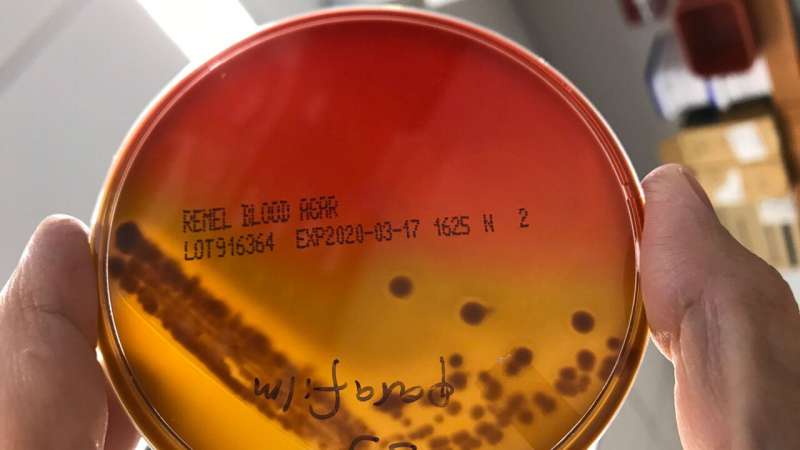This article has been reviewed according to Science X's editorial process and policies. Editors have highlighted the following attributes while ensuring the content's credibility:
fact-checked
trusted source
proofread
First-of-its-kind study characterizes urinary microbes in children

Until recently, it was believed that human urine is sterile, but advanced culturing techniques and DNA sequencing have revealed that bacteria and other microbes—such as viruses and fungi—inhabit the human bladder and urinary tract, known collectively as the "urobiome." Now, in a study among the first of its kind, Dr. Tanya Sysoeva, an associate professor of microbiology at The University of Alabama in Huntsville (UAH), a part of the University of Alabama System, has taken this research a step further, demonstrating that, even in the bladders of children, a pediatric urobiome exists that appears to be affected by early urologic events.
The work is published in the Journal of Pediatric Urology.
"Little is known about the urobiome in children," Sysoeva explains. "We only have sparse data as a field now. Our study is a pilot project aimed to characterize the urobiome of children to identify associations based on urinary tract infection (UTI) history. We are showing that age, sex and urinary tract infections affect urobiome composition. Other potential factors implicated are antibiotic use, circumcision, surgeries and vesicouretheral reflux, but are not explored yet.
"We looked for differences in microbial composition, down to species level, in boys and girls, and at the history of UTIs. Using advanced sequencing, we got signatures of bacterial DNA in most samples, but only analyzed 61% of samples with the available sequencing reads over our rigorous threshold to get robust species-level data."
The project demonstrates that urobiome diversity increases with age.
"The urinary bladder and urinary tract in general were considered completely devoid of microbes before the last decade, back at the start of the microbiome field and some of the large-scale characterization projects such as the Human Microbiome Project," the researcher notes. "Therefore, this microbiome niche, the urobiome, is one of the least studied. Similar to adults, urobiomes were distinct across individuals and varied by sex. The urobiome of females showed higher diversity, for example. Additionally, several species were significantly overrepresented in females when compared to males. Our study suggests a connection between decreased overall urobiome diversity and recurrent UTIs in children."
The "microbiome" is the collection of all microbes and their genes that naturally live on or inside the human body. It is estimated the human body is colonized by 10–100 trillion microbial cells containing 100-fold more genes than the human genome. Although microbes are so small that a microscope is required to see them, they contribute significantly to human health and wellness.
The path to more proactive treatment
Sysoeva reports the evidence collected suggests the presence of specific microbes and their abundance may affect the development and progression of urinary tract infections.
"Diversity in the urobiome was shown to be indicative or promoting of the effect we call 'colonization resistance,'" the researcher says. In fact, commensal bacteria—bacteria residing in or on a human without harming human health—or beneficial microbes actually protect the niche from invasion of a pathogenic species.
"We hope to learn more about the urinary tract and then be able to correlate predisposition to UTIs or other urological conditions with urobiome composition or marker microbe presence. Wouldn't it be nice to be able to predict and adjust before some health issue develops without the need for an invasive procedure or drug intervention?"
Sysoeva, along with her research collaborators, Dr. Lisa Karstens of Oregon Health & Science University, and Dr. Maryellen Kelly of Duke University will continue sample collection and analyses to prepare for an upcoming presentation of their results.
The UAH researcher's work has been supported by additional study, as well. Layla Jeries, a UAH alumna and current graduate student in the Sysoeva laboratory, worked on an extensive review of this emerging pediatric urobiome field that appeared in the journal Frontiers in Pediatrics. "Her work highlights the progress made in the last four years and points out many unstudied questions," Sysoeva says.
For example, it's unknown how the urobiome is initially colonized, how it develops during childhood, and if early urobiome development and changes can lead to a predisposition to recurrent UTIs.
"The current consensus in the human microbiome field is that the newborn [urobiome] is being colonized during and right after birth," the researcher concludes in looking to the future of her work. "We will continue with pediatric and adult urobiome studies to better characterize development of the urobiome across the lifespan, to include studies of connections between recurrent UTI and urobiome and work on characterizing those urinary microbes as well, so we can understand how they function. We have a long road ahead of us."
More information: Maryellen S. Kelly et al, Characterization of pediatric urinary microbiome at species-level resolution indicates variation due to sex, age, and urologic history, Journal of Pediatric Urology (2024). DOI: 10.1016/j.jpurol.2024.05.016

















